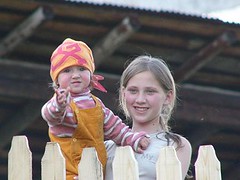 |
| Armenian girl (Photo credit: narek781) |
A recently published story has highlighted the existence of many Armenians living in Turkey who have changed their identities and religious practices to escape persecution.
According to the report, those who have been hiding their real identity for almost a century reside mostly in Turkey’s eastern regions. They have embraced the Sunni or Alawite sects of Islam and live with Turkish or Kurdish identities. Still, a tiny community living in villages in the Sason district of Batman province preserves their Christianity. Stressing that no one really knows the exact number of crypto-Armenians, Hadjian says he has seen that many of them are scared to acknowledge their Armenian identity. He quotes a crypto-Armenian in Palu: “Turkey is still a dangerous place for Armenians.”
The crypto-Armenians who live under various guises do not socialize with those who live openly as Armenians, and evade contact with strangers. According to Hadjian, some reject their identities even though they accept their parents or grandparents were Armenian and their Turkish and Kurdish neighbors still call them “Armenians” or “infidels.” Others acknowledge their real identity but say they keep it secret from their offspring.
To church in winter, to mosque in summer
Hadjian says that identifying crypto-Armenians is not easy, recounting several examples. The last Armenian in Amasya, Rafel Altinci, for instance, was brought up as a Christian and graduated from the same school as Hrant Dink, the Armenian journalist who was killed. He then converted to Islam, married a Turkish woman and raised his daughter as a Muslim. Only recently has he begun to acknowledge that he is an Armenian. Jazo Uzal, a villager from the province of Mus, goes to church in Istanbul, where he spends the winters, but when he returns home during the summer he observes the Muslim rites of worship, including fasting.
In Diyarbakir, lawyer Mehmet Arkan says he became aware of his family’s Armenian identity at the age of seven. “Until 10 years ago, we used to conceal our identity from everybody, but being an Armenian in Diyarbakir is no longer dangerous,” Arkan says, pointing to the restoration of the Surp Giragos Church in the city. He explains he does not feel less Armenian for being a Sunni and performing Muslim prayers.
In some cases, secret Armenians have been transformed in surprising ways. The Ogasyan clan from Bagin village in Palu, for instance, survived the “events” of 1915 and emigrated to the United States, settling in Rhode Island. But before their departure, a Kurdish tribal chief abducted the family’s youngest son Kirkor to use him as a laborer in his fields. The chief then married off the underage Kirkor to an orphan named Zerman. The couple settled in a village in Palu, converted to Islam and adopted Turkish names. They even went on a Hajj pilgrimage to Mecca together.
Years later, relatives in the U.S. got in touch with Kirkor and Zerman. Today the couple’s grandson is an imam in Harput, while their second-generation nephew Oshayan Cloloyan is the archbishop of the Armenian Church in New York.
Hadjian writes about the presence of crypto-Armenians also in Tunceli and its environs, and recounts an encounter he had in Sason. The journalist describes a girl aged 6 or 7 in a group of Armenians heading to the Raman Mountains on pilgrimage. Due to the force of the wind, the white sack on the girl’s back turns around to reveal the Armenian cross. The journalist approaches the girl to take a picture. She hides her face behind her scarf, and when asked whether she is Armenian or has Armenian relatives, she answers: “We are Muslims.”
Source - al-monitor





